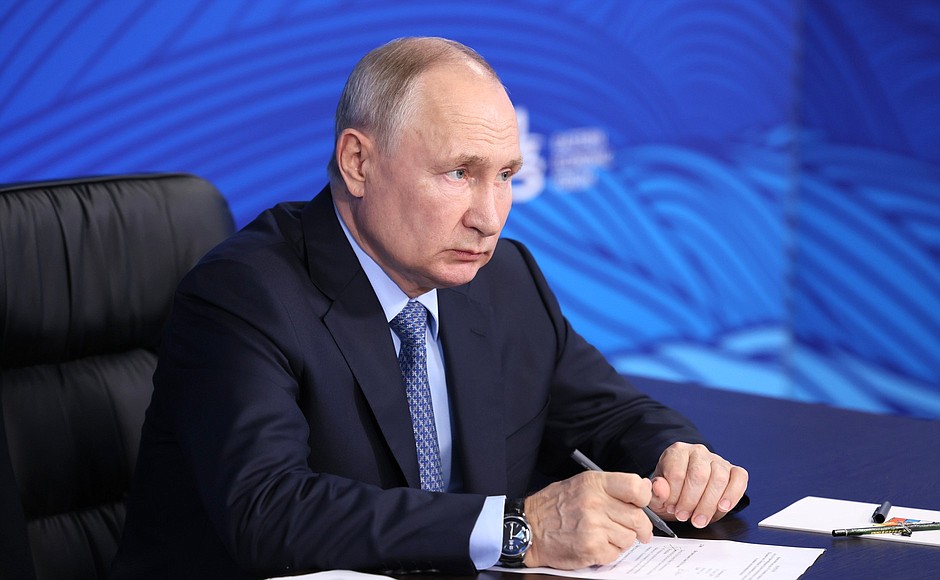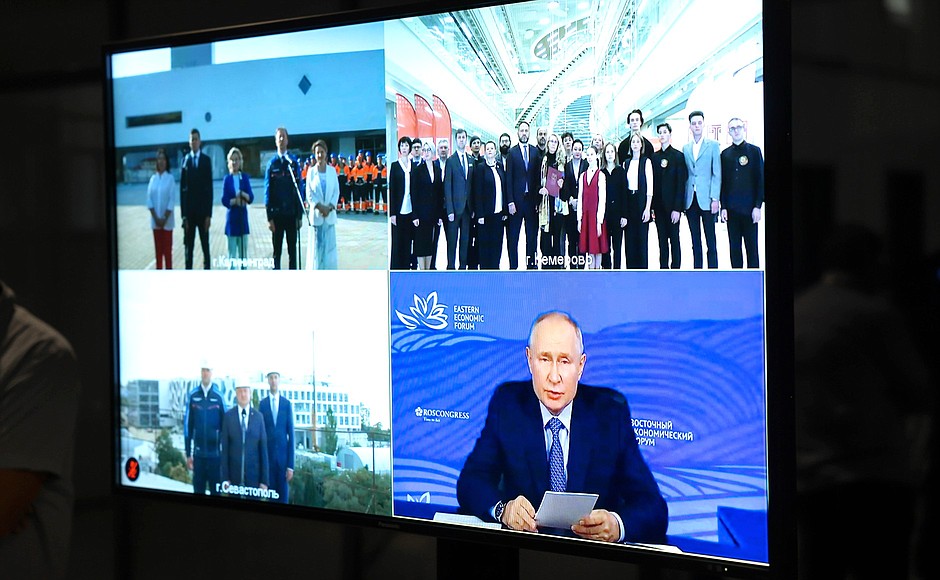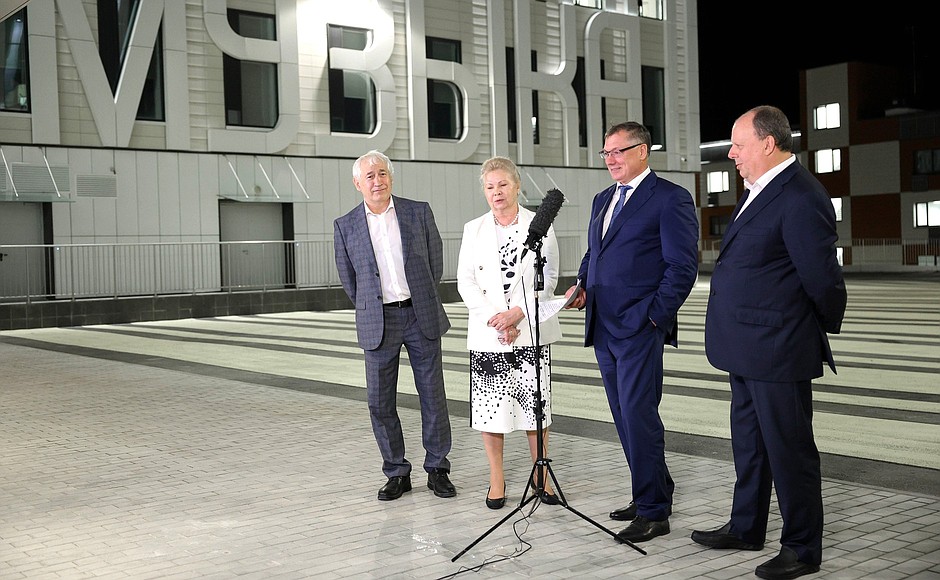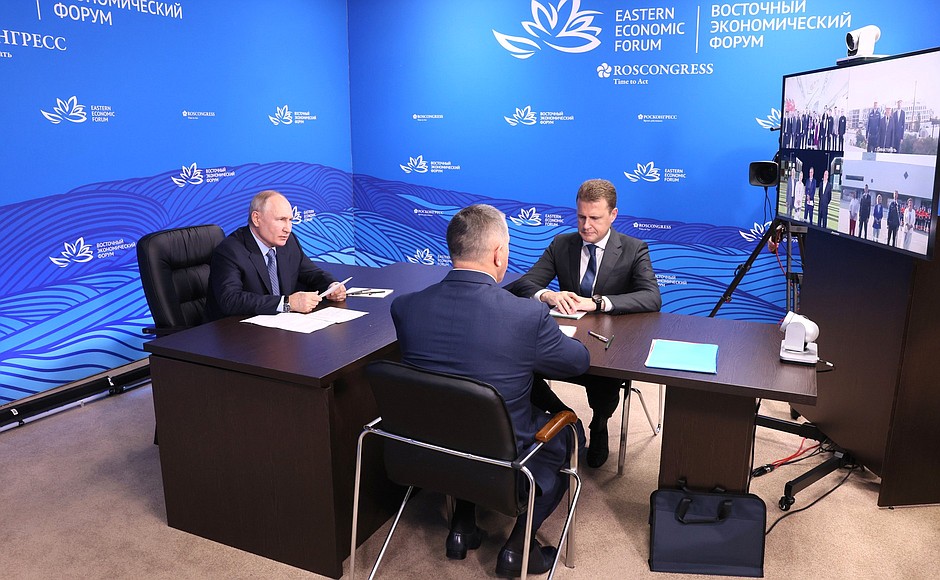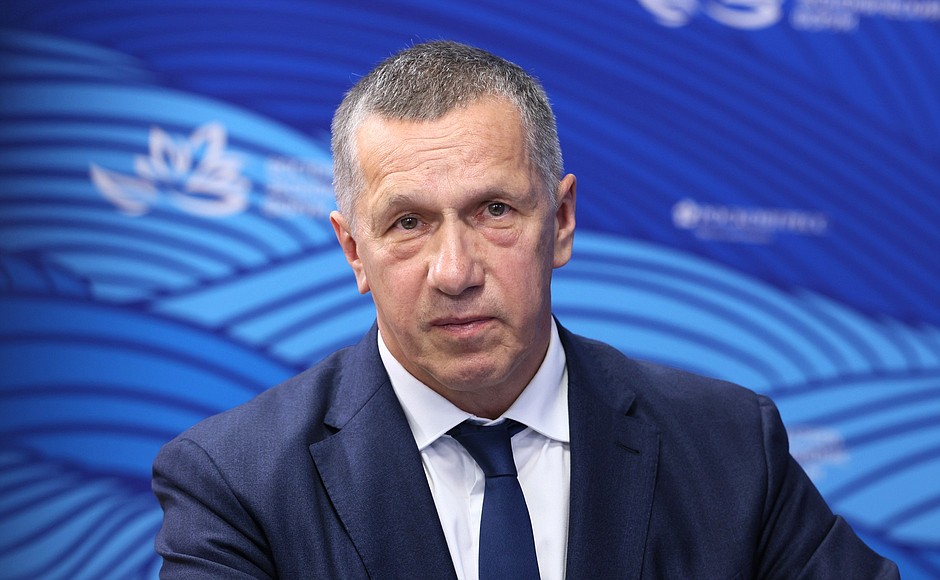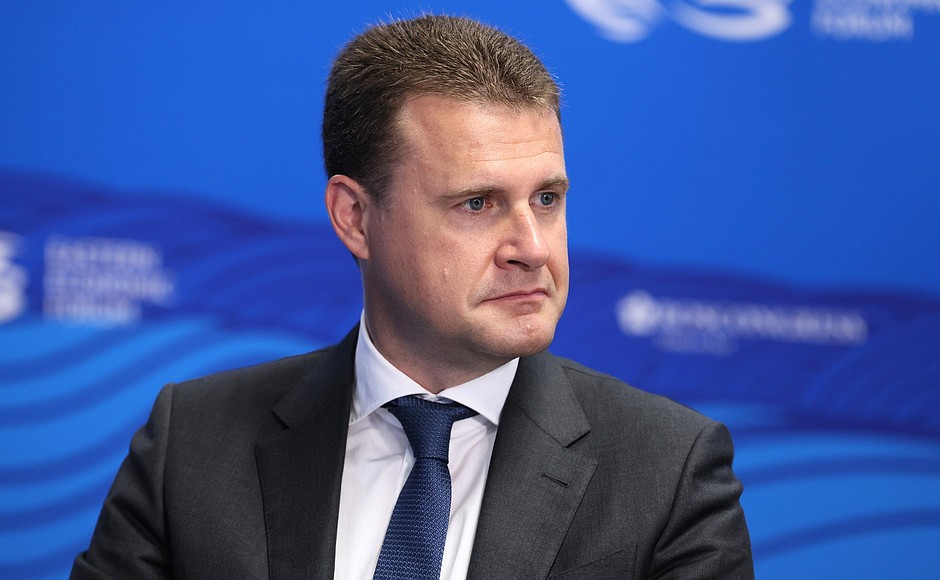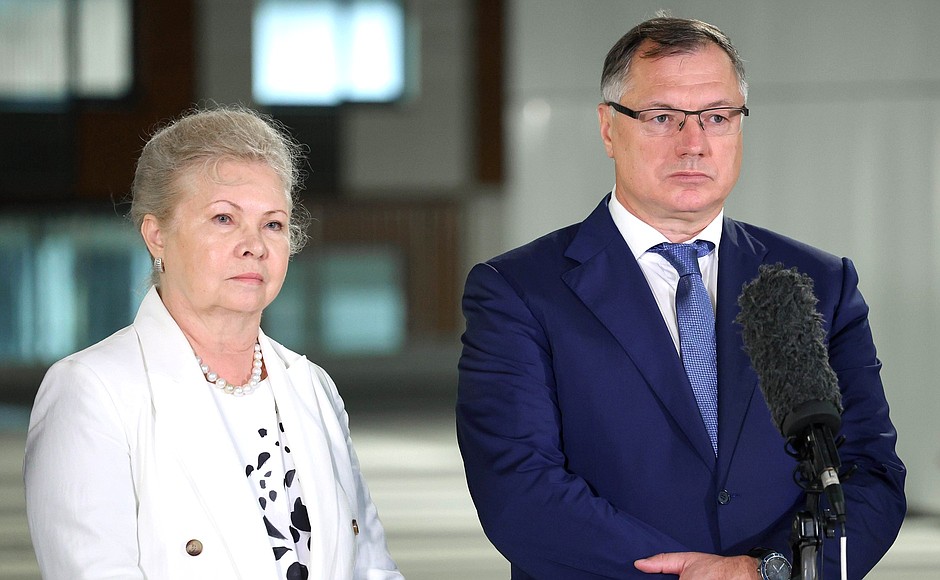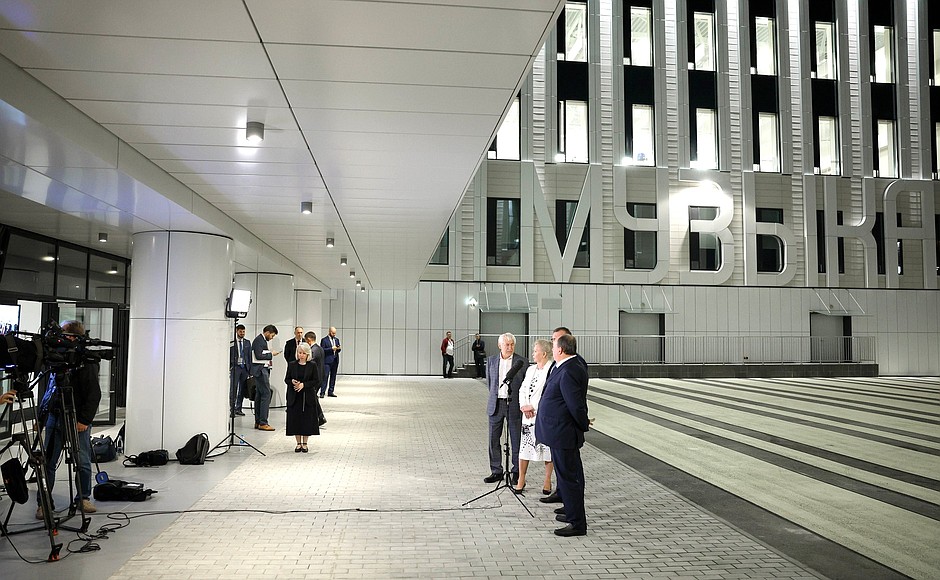The President also discussed the progress of the project to create cultural clusters in the regions with videoconference participants who were at the construction sites.
* * *
President of Russia Vladimir Putin: Colleagues, good afternoon.
Today we will discuss how the construction of museum, theatre and educational complexes is progressing here in Vladivostok, where we are now, as well as in Kemerovo, Sevastopol and Kaliningrad. As a reminder, this large cultural and educational project was launched in 2018.
According to the plan, cultural centres must include theatre and concert halls, museum and exhibition spaces, as well as modern premises for art and dance schools.
These cultural centres are created to increase the accessibility of the best examples of the musical, theatrical and fine arts for millions of people. And there will be additional opportunities in the regions to discover talent, above all for children and young people, of course.
For example, here in Vladivostok, on Russky Island, as Mr Trutnev told me, studies for students at the new educational complex began on September 1. The complex features branches of the Moscow State Academy of Choreography and the Central Music School and has well-equipped classes and rehearsal rooms, among other things.
Several education institutions in Kemerovo and Kaliningrad, created as part of this project, have also opened. This means that hundreds, and perhaps even thousands of children will be able to receive high-quality education in their home regions. Let me repeat, these institutions will help identify talent and provide support from the best mentors.
Let me stress that cultural clusters give a good boost to the comprehensive development of the regions in addition to their educational mission. Nearby public spaces, walking areas and parks become points of growth and attraction for locals and tourists. A modern, harmonious living environment is being created in cities thanks to cultural clusters and their projects for sports and landscaping, and the development of new creative industries in general.
And of course, the opening of new cultural complexes needs to be expedited. I know the problems in this area, and we have talked about this many times, both with Mr Khusnullin and those who are involved in this process in one way or another; I know about the problems that exist here. However, this process must be accelerated without compromising the quality of construction or equipment.
In total, cultural complexes in Kemerovo, Sevastopol, Kaliningrad and Vladivostok include 46 facilities. According to the materials presented, today, 29 of them have opened.
Today I would like to hear and discuss the status of the construction of the remaining facilities and when it is planned to complete them.
Let’s discuss all the issues put forward. Mr Khusnullin has the floor. Please.
Deputy Prime Minister Marat Khusnullin: Mr President,
As you said, four huge complexes are under construction, which are unique not only for Russia, but for the entire world, because they have everything in one place – theatres, museums and, what’s most important, they include education – in music, choreography and ballet.
In order to execute this, the best Russian and world architects were invited. Despite the pandemic-related difficulties, when many architects could not come here to supervise things, and despite current difficulties related to export restrictions, nobody refused to cooperate, and work is underway both with the architects and the designers. There have been some delays, but we have almost reached the finish line at this point.
For example, today we are in Vladivostok. This complex must, of course, be seen, because it is a masterpiece of architecture and artistic thought. And most importantly, it has great cultural significance. It is located in a beautiful place: the bay is behind us; you can see the sea. A beautiful view. I inspected the finished facilities today, and the quality is at the highest global levels. The complex is already in use. By the end of next year, we must complete the theatre and museum complex on Orlinoye Gnezdo (Eagle’s Nest) Hill in Vladivostok. This project is very intense and will now require additional mobilisation. We have carried out the organisational work to revise the supply and financing schedules; we will work hard, and we will try to complete the construction by the end of next year, 2024.
The next facility, which is another masterpiece of architectural design, is the centre in Sevastopol, the Academy of Choreography, which will be completed by the end of this year. And we plan to complete the main construction of the entire complex by the end of 2024.
On the screen is the next facility that is also under construction – an academy of choreography in Kemerovo. It has already been commissioned. You have seen it in Kemerovo. Again, I want to say that the facility is an architectural masterpiece, and construction has to be completed by the end of 2024.
The next one is the museum complex in Kaliningrad. You can see my colleagues next to it, on the screen. It will open by the end of this year. It has about 16 exhibition halls; it is being implemented together with the Tretyakov Gallery. The theatre and culture centre will also be completed by the end of 2024. There were problems with logistics. As you know, there was an attempt to block the delivery of construction materials, but nevertheless, we have managed to continue with the logistics, the ferry crossing, transporting cement and other materials. We plan to complete this project by the end of 2024.
We have strict deadlines and we have the right people. I am sure that the goal you set will be completed. And this is a very worthy visual addition to all our cities and the entire country; it will give a powerful impetus to development.
Today we have discussed the development of the Far Eastern Federal District. The creation of such centres lifts these cities to a different level in terms of culture, not to mention 5,000 new jobs and plus 2,300 students: specifically those studying the arts. This is a huge asset. Today, perhaps the Chinese are the only ones in the world starting to implement projects like this, where the best culture of the country, education and accommodation are all in one place… We are also creating living space: for example, 500 students can live in Vladivostok permanently, almost 400 flats here are ready, where both teachers and parents with children can live, and all of this is being done at a good, high-quality level.
So, we are working hard to fulfil the goals you have set.
<…>
Vladimir Putin: I would like to say a few words in conclusion. Firstly, I would like to thank everyone for this work; it is undoubtedly monumental. Our colleagues rightly said that there is nothing like it in the world, neither this volume of construction in the cultural sphere, nor such a diverse approach to the construction of cultural facilities. There are surely no analogues today, and perhaps no analogues even in the history of our country.
I would like to note the geography: Sevastopol, Crimea, our enclave territory of the Kaliningrad Region, then Vladivostok, which is also on the border of the Russian Federation, in the Far East, where we are now. Kemerovo is located in the centre of the country, in Siberia, our mining region, and people there deserve to have first-class cultural facilities next to their homes, which our country can be proud of.
The diversity of these facilities makes it possible to practice the arts, offer training to one’s kids, raise them in this environment in a variety of areas. There are opera studios, dance studios, art schools and, in fact, branches of the Conservatory, opera and ballet theatres, and art schools. These are branches of our leading museums: the Hermitage and Tretyakov Gallery. People no longer need to travel to St Petersburg or Moscow in order to see the works of art kept in these leading museums not only of Russia, but of the world.
When the idea of these complexes was born, I thought, of course – after repeated conversations with the leaders of the museum community – that we have a huge number of works of art in storage. Why are they there, who can see them? The main exhibitions can also be moved from city to city. Step by step, with no hurry, of course; we must handle works of art with care, because while they are the property of all our people, they should nevertheless travel in compliance with appropriate safety measures, including technological safety measures. It can and should be done, so that people have the opportunity to see the best works of fine art from our museums up close.
And most importantly, it is an opportunity for families who live in these areas to provide a well-rounded upbringing for the younger generation, which I think is extremely important.
Conditions are being created to develop a unique urban environment around the new facilities. I know that something new and interesting is starting to sprout up near almost every one of these facilities that would be of interest to people who live in these areas.
The Governor of Sevastopol has just spoken about this. I know it, I was there, and I saw it. Of course, there are undeveloped territories there, half-abandoned in what is actually a unique place, a unique place. And after facilities like what we are discussing now are built there, of course, like it or not, all the leaders, mayors of cities and heads of the regions of the Federation where these centres are being built will have to think of something and take measures to improve the surrounding areas.
This is why every point that I have just mentioned and that was named by the speakers is important.
One more thing I would like to draw the regional leaders’ attention to: we are now discussing an absolutely unique project for Russia and for the entire world. However, I am asking the heads of the regions to not forget about the existing and operating cultural institutions in their regions, because such a huge, necessary and useful construction project must not lead you to forget about the cultural institutions you already have, people who work there, their financial well-being, and housing.
We are now saying that living conditions for teaching staff and students are being created right alongside the creation of the institutions that we are discussing. And this is right, because we initially planned to do that so people who come to these regions to study and work will have normal living conditions. But I would also ask you not to forget about people who have been working in the regions for a long time in existing cultural institutions, and about their level of wages and living conditions.
This does not mean that there is no need to create facilities like those we are talking about. They will certainly be a driver of cultural development in these regions. And without creating and developing this environment, it is impossible to create proper conditions for people’s lives. So, you and I are doing the right thing, for which there is a lot of need, and I hope that we will do a good job and get it done on time.
A colleague from Kemerovo, I believe, recalled a saying that culture is impossible without progress. Nothing is possible without progress, because life moves forward, so in this case I would like to address a top manager, or in fact the General Director of Stroytransgaz: moving forward is necessary. You have said that you see a certain delay in schedules. Yes, I know it, and I also know the reasons, which are out of your hands to a significant extent and related to today’s events, like the need to replace subcontractors and so on. But, as far as I know, the contracts have generally been signed, and there are no further problems there. I am asking you to complete everything within the agreed time frame.
Overall, I want to thank you for the enormous amount of work that has been done. I hope that all this great joint work will be completed soon.
Thank you very much. All the best.
